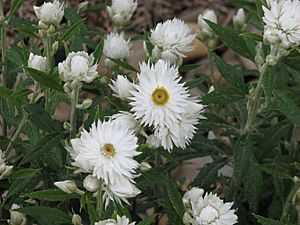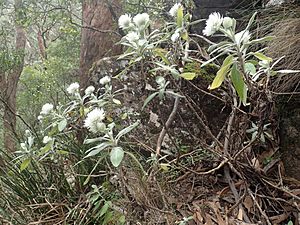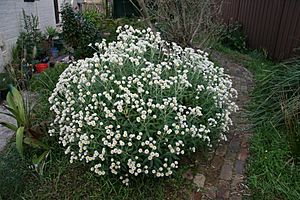White paper daisy facts for kids
Quick facts for kids White paper daisy |
|
|---|---|
 |
|
| Coronidium elatum | |
| Scientific classification | |
| Kingdom: | |
| (unranked): | |
| (unranked): | |
| (unranked): | |
| Order: | |
| Family: | |
| Genus: |
Coronidium
|
| Species: |
C. elatum
|
| Binomial name | |
| Coronidium elatum (A.Cunn. ex DC.) Paul G.Wilson
|
|
| Synonyms | |
|
Helichrysum elatum A.Cunn. ex DC. |
|

The Coronidium elatum, also known as the white paper daisy or tall everlasting, is a beautiful plant found in eastern Australia. It's a type of shrub that grows in open forests. This plant is known for its lovely white flowers that bloom in spring. For many years, it was called Helichrysum elatum, but its name was changed in 2008 after scientists studied it more closely.
Contents
About the White Paper Daisy
The white paper daisy is a woody shrub that can grow from about 0.6 to 2 meters (2 to 6.5 feet) tall. Its leaves are shaped like eggs or ovals and can be up to 12 centimeters (4.7 inches) long. The stems and the underside of the leaves are covered in soft white hairs. The top of the leaves has fewer hairs.
The flowers of the white paper daisy usually appear from June to November. They are most plentiful in September. Each flower head is about 2.5 to 4.5 centimeters (1 to 1.8 inches) wide. The center of the flower is yellow, and the petals, which are actually special leaves called bracts, are white.
Where It Grows
You can find Coronidium elatum in the southeastern part of Queensland, along the eastern coast of New South Wales, and even a little bit into eastern Victoria. It likes to grow in soils that are rich in nutrients, especially those made from shale, basalt, or sandstone.
This plant often grows in open forests or at the edges of rainforests. It can be found under trees like brown barrel (Eucalyptus fastigata), mountain grey gum (Eucalyptus cypellocarpa), messmate (Eucalyptus obliqua), or white stringybark (Eucalyptus globoidea). It can grow very well after bushfires or in areas where the ground has been disturbed.
Plant Names and History
Plants, like people, have scientific names that help scientists around the world know exactly which plant they are talking about. The tall everlasting was first collected by an English botanist and explorer named Allan Cunningham. He described it in 1838 and gave it the name Helichrysum elatum. The word elatum is Latin for "tall," which makes sense because it's a tall plant!
For a long time, scientists knew that the large group of plants called Helichrysum was a bit mixed up. It contained many different kinds of daisies that weren't actually closely related. So, many of these plants were moved to new groups, or "genera."
In 2008, a botanist named Paul Graham Wilson created a new group called Coronidium for 17 types of daisies found in eastern Australia. That's when the white paper daisy got its new name, Coronidium elatum.
There are also a few slightly different types of this plant, called subspecies. For example, subspecies minus is found only in New England National Park. It's a bit smaller, growing up to 80 centimeters (31 inches) high, and has smaller, thinner leaves.
Growing in Gardens
The white paper daisy is a great plant for gardens. It produces lots of flowers and grows quickly. It can handle frost and likes to grow in full sun or partial shade. You can grow new plants from seeds or by taking cuttings from an existing plant. However, cuttings can sometimes rot, so it's a bit tricky.
There's even a special type of Coronidium elatum called 'Sunny Side Up' that you can buy for your garden.
Images for kids
-
Subspecies elatum in the Gibraltar Range National Park
See also
 In Spanish: Coronidium elatum para niños
In Spanish: Coronidium elatum para niños



